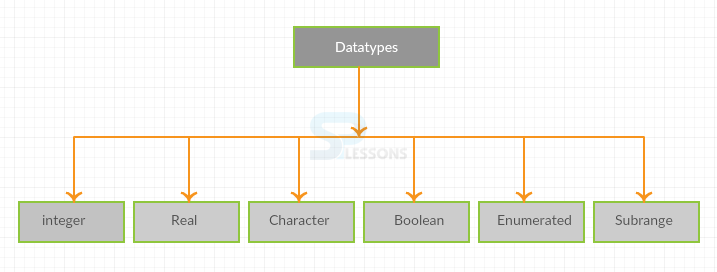 Description
Description
Every programming language consists of some kind of data. Datatype shows the specific data entered into a program. Data Types are the
keywords used to declare the type of the variable used in the program such as integer, real, character and string. The data types are utilized inside sort frameworks, which offer different methods for characterizing, executing and utilizing them.  Description
Description
The following are the various variables available in pascal language.
Integer is a positive or negative number without decimal value. Integer is of only number, without comma and decimal value. The following is an example.
[c]age: integer = 24;[/c]
A
- Integer
- Character
- Constants
- Real
- Enumerated
- Subrange
char will store a single character. The utilization of byte or char as data type gives documentation with regards to the reason for the utilization of the specific variable. The following is an example.
[c]
var ch: char;
c: byte;
begin
ch := 'A'; c := 65; { are the same action, and are legal }
ch := 65; c := 'A'; { while they are internally the same values,
direct assignment between Chars and Bytes is illegal }
end.[/c]
The constants will make a code more efficient and pascal coding will allow character, string, logical constants. The the constants will be declared with the const. The following is the syntax declaration.
[c]const Identifier = contant_value;[/c]
The following is an example.
[c]
PIE = 3.141592;
NAME = 'Welcome To SPlessons';[/c]
The user defined data types are called as enumerated types and in this case the values will be specified in a list format. The following is the syntax for the enumerated data types.
[c]type enum-identifier = (item1, item2, item3 etc )[/c]
The following is an example.
[c]type
Technologies = (Java, sql server, php, c, c++);[/c]
The sun range type data types are used to keep the restrictions on range of the variable and the following is an better example to understand.
[c]var speed: 60 ... 100;[/c]
The real is the another data type to hold the decimal values and it will have a range from 3.4x10-38 to 3.4x1038. The following is an example which describes all the data types.
Test.pas
[c]
PROGRAM Test;
VAR
x : REAL;
i : INTEGER;
j : INTEGER;
BEGIN
x := 12.449;
i := 10;
j := -300;
WRITE('This is some text');
WRITELN('Unformatted integer ',i);
WRITELN('Unformatted integer computation ',i*i);
WRITELN('formatted integer',i:4);
WRITELN('formatted integer',j:4);
WRITELN('Unformatted real ',x);
WRITE('Formatted real');
WRITE(x:8:2);
WRITELN('all in one line');
END.
[/c]
In the above example, x, i, j are the variables with respective data types real, integer, integer. The pascal language is not a case sensitive language. The writeln is used to print the data which was given by user.
Output: Now compile the code result will be as follows.
[c]This is some textUnformatted integer 10
Unformatted integer computation 100
formatted integer 10
formatted integer-300
Unformatted real 1.2449000000000000E+001
Formatted real 12.45all in one line[/c]
 Key Points
Key Points
- The scalar, pointer and structured are the type of pascal data types.
- The array and record both are the structured data types.
- The enumerated and sub range are the user defined data types.




